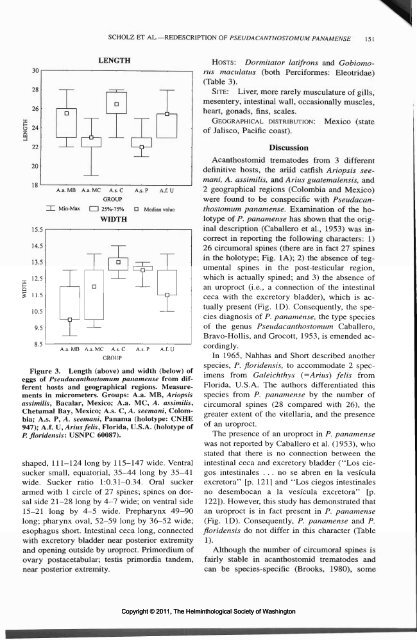The Helminthological Society of Washington - Peru State College
The Helminthological Society of Washington - Peru State College
The Helminthological Society of Washington - Peru State College
You also want an ePaper? Increase the reach of your titles
YUMPU automatically turns print PDFs into web optimized ePapers that Google loves.
SCHOLZ ET AL.—REDESCRIPTION OF PSEUDACANTHOSTOMUM PANAMENSE 15 1<br />
5 24<br />
z<br />
15.5<br />
14.5<br />
13.5<br />
11.5<br />
10.5<br />
9.5<br />
LENGTH<br />
A.a. MB A.a. MC A.s. C A.s. P A.f. U<br />
GROUP<br />
I Min-Max CH 25%-75% D Median value<br />
WIDTH<br />
8.5<br />
A.a. MB A.a. MC A.s. C A.s. P A.f. U<br />
GROUP<br />
Figure 3. Length (above) and width (below) <strong>of</strong><br />
eggs <strong>of</strong> Pscudacanthostomum panamense from different<br />
hosts and geographical regions. Measurements<br />
in micrometers. Groups: A.a. MB, Ariopsis<br />
assimilis, Bacalar, Mexico; A.a. MC, A. assimilis,<br />
Chetumal Bay, Mexico; A.s. C, A. seemani, Colombia;<br />
A.s. P, A. seemani, Panama (holotype: CNHE<br />
947); A.f. \J, Arius felis, Florida, U.S.A. (holotype <strong>of</strong><br />
P. floridensis: USNPC 60087).<br />
shaped, 111-124 long by 115-147 wide. Ventral<br />
sucker small, equatorial, 35-44 long by 35-41<br />
wide. Sucker ratio 1:0.31-0.34. Oral sucker<br />
armed with 1 circle <strong>of</strong> 27 spines; spines on dorsal<br />
side 21-28 long by 4-7 wide; on ventral side<br />
15-21 long by 4-5 wide. Prepharynx 49-90<br />
long; pharynx oval, 52-59 long by 36-52 wide;<br />
esophagus short. Intestinal ceca long, connected<br />
with excretory bladder near posterior extremity<br />
and opening outside by uroproct. Primordium <strong>of</strong><br />
ovary postacetabular; testis primordia tandem,<br />
near posterior extremity.<br />
HOSTS: Dormitator latifrons and Gobiomorus<br />
maculatus (both Perciformes: Eleotridae)<br />
(Table 3).<br />
SITE: Liver, more rarely musculature <strong>of</strong> gills,<br />
mesentery, intestinal wall, occasionally muscles,<br />
heart, gonads, fins, scales.<br />
GEOGRAPHICAL DISTRIBUTION: Mexico (state<br />
<strong>of</strong> Jalisco, Pacific coast).<br />
Discussion<br />
Acanthostomid trematodes from 3 different<br />
definitive hosts, the ariid catfish Ariopsis seemani,<br />
A. assimilis, and Arius guatemalensis, and<br />
2 geographical regions (Colombia and Mexico)<br />
were found to be conspecinc with Pseudacanthostornum<br />
panamense. Examination <strong>of</strong> the holotype<br />
<strong>of</strong> P. panamense has shown that the original<br />
description (Caballero et al., 1953) was incorrect<br />
in reporting the following characters: 1)<br />
26 circumoral spines (there are in fact 27 spines<br />
in the holotype; Fig. 1A); 2) the absence <strong>of</strong> tegumental<br />
spines in the post-testicular region,<br />
which is actually spined; and 3) the absence <strong>of</strong><br />
an uroproct (i.e., a connection <strong>of</strong> the intestinal<br />
ceca with the excretory bladder), which is actually<br />
present (Fig. ID). Consequently, the species<br />
diagnosis <strong>of</strong> P. panamense, the type species<br />
<strong>of</strong> the genus Pseudacanthostomum Caballero,<br />
Bravo-Hollis, and Grocott, 1953, is emended accordingly.<br />
In 1965, Nahhas and Short described another<br />
species, P. floridensis, to accommodate 2 specimens<br />
from Galeichthys (= Arius) felis from<br />
Florida, U.S.A. <strong>The</strong> authors differentiated this<br />
species from P. panamense by the number <strong>of</strong><br />
circumoral spines (28 compared with 26), the<br />
greater extent <strong>of</strong> the vitellaria, and the presence<br />
<strong>of</strong> an uroproct.<br />
<strong>The</strong> presence <strong>of</strong> an uroproct in P. panamense<br />
was not reported by Caballero et al. (1953), who<br />
stated that there is no connection between the<br />
intestinal ceca and excretory bladder ("Los ciegos<br />
intestinales . . . no se abren en la vesicula<br />
excretora" [p. 121] and "Los ciegos intestinales<br />
no desembocan a la vesicula excretora" [p.<br />
122]). However, this study has demonstrated that<br />
an uroproct is in fact present in P. panamense<br />
(Fig. ID). Consequently, P. panamense and P.<br />
floridensis do not differ in this character (Table<br />
1).<br />
Although the number <strong>of</strong> circumoral spines is<br />
fairly stable in acanthostomid trematodes and<br />
can be species-specific (Brooks, 1980), some<br />
Copyright © 2011, <strong>The</strong> <strong>Helminthological</strong> <strong>Society</strong> <strong>of</strong> <strong>Washington</strong>
















